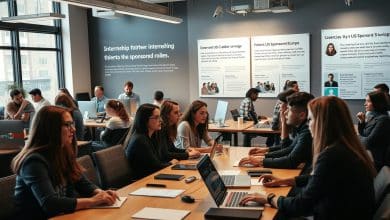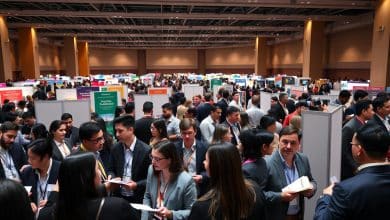How Do International Students Build a Career Plan That Actually Works?
Navigating the American job market presents unique hurdles for those studying abroad. Complex visa regulations, intense competition, and cultural differences create significant barriers. Many face these challenges while hoping to connect with top employers.
The United States offers remarkable professional possibilities across thriving sectors. Technology, finance, healthcare, and engineering actively seek global talent. These industries provide valuable experience that translates to excellent positions worldwide.
Success requires a strategic approach rather than random efforts. This guide provides practical steps for understanding visa options and conducting self-assessment. Readers will learn to develop actionable strategies for networking and interview preparation.
Understanding the US Job Market and Visa Options
Comprehending how American companies hire and what they value is crucial for those seeking work authorization during their academic programs. Employers prioritize technical competencies alongside cultural adaptability and strong communication skills. Understanding legal work eligibility remains absolutely essential.
Exploring CPT, OPT, and H-1B Options
Several visa pathways exist for employment. Curricular Practical Training (CPT) allows work during studies. Optional Practical Training (OPT) provides twelve months post-graduation.
STEM degrees may qualify for a twenty-four-month extension. The H-1B visa requires employer sponsorship. Different visa types carry specific work restrictions and requirements.
Navigating Cultural and Legal Challenges
International Student Services Offices (ISSS) provide vital guidance. They help navigate complex regulations and critical deadlines. These professionals offer specialized workshops and networking events.
Identifying companies that sponsor international workers is key. Understanding employer expectations and legal compliance ensures successful employment opportunities. Early consultation with ISSS professionals is highly recommended.
Conducting a Personal SWOT Analysis for Career Direction
The SWOT framework offers a structured approach to identifying optimal professional trajectories. This method helps individuals understand their competitive advantages and areas needing development. It creates a clear roadmap for targeting suitable positions.
Identifying Strengths & Weaknesses
Strengths include natural talents and developed competencies. These abilities differentiate candidates in competitive markets. Technical expertise and soft skills both contribute to professional value.
Weaknesses represent areas requiring growth or improvement. Honest self-reflection identifies where additional training might benefit. Recognizing limitations allows for strategic skill development.
Mapping Opportunities and Threats
Opportunities align personal interests with market demands. High-growth industries often seek specific skill sets. Research reveals which companies support visa sponsorship.
Threats include external factors like immigration regulations. Economic conditions and industry competition also impact success. Understanding these challenges helps set realistic objectives.
This analysis provides clarity for targeting appropriate roles. It establishes a foundation for all job search activities. The process enables informed decisions about professional pathways.
Developing a Career Plan for International Students
A structured timeline provides the roadmap needed to navigate employment opportunities effectively. Breaking objectives into timed phases creates accountability and measurable progress throughout the search process.
Setting Milestones for Success
The 30-60-90-120 day framework offers a concrete example of strategic planning. This approach helps individuals stay focused on their professional goals.
During the first 30 days, key actions include attending ISSS meetings and updating resumes. Researching target companies lays the foundation for future applications.
By day 60, active job search activities should begin. This includes applying for internships and building professional connections on LinkedIn.
The 90-day mark involves following up on applications and scheduling mock interviews. This period focuses on refining interview skills and networking strategies.
At 120 days, reassessment becomes crucial. Individuals should seek feedback and prepare for visa timelines like OPT or H-1B applications.
Before pursuing any position, reflection ensures alignment with long-term objectives. Asking critical questions helps evaluate whether a role matches skills and supports growth.
Choosing opportunities that genuinely fit personal goals leads to meaningful professional development. This thoughtful approach builds sustainable success rather than just securing employment.
Optimizing Your Resume and Application Process
Well-crafted resumes and cover letters significantly increase the likelihood of securing interviews with target companies. These documents serve as the primary screening tools used by hiring managers. Quality applications demonstrate genuine interest and preparation.
Customizing Your Resume for Employer Expectations
American employers expect concise, achievement-focused resumes. Documents should typically fit on one page for candidates with limited professional experience. Using action verbs and quantifying results creates stronger impact.
Tools like Grammarly and VMock provide valuable feedback on writing quality and formatting. These resources help ensure materials meet professional standards. They catch errors that might otherwise undermine credibility.
Most companies use Applicant Tracking Systems (ATS) to screen applications. Jobscan analyzes compatibility between resumes and specific job descriptions. Aim for at least 60% keyword alignment to pass automated screenings.
Crafting a Compelling Cover Letter
Cover letters should connect personal achievements directly to role requirements. They demonstrate how specific skills match the company’s needs. This personalized approach shows genuine interest beyond generic applications.
Researching each organization’s mission and values strengthens application materials. Demonstrating understanding of company culture creates meaningful connections. This strategic approach yields better results than mass applications.
Thorough preparation distinguishes serious candidates from casual applicants. Investing time in customization pays dividends throughout the hiring process. Quality always trumps quantity when seeking meaningful opportunities.
Mastering Job Search and Networking Strategies
Many professional opportunities remain hidden from public job boards. Strategic networking becomes essential for discovering these unadvertised positions. Building genuine connections often opens doors that applications alone cannot.
Leveraging Career Fairs and Alumni Connections
Campus events and career fairs provide direct access to employers. These gatherings allow meaningful conversations with hiring managers. Students should prepare specific questions about company culture and sponsorship policies.
Networking works best as a long-term relationship building process, not a transactional exchange.
University alumni networks offer another powerful resource. Graduates often provide insider information about hiring processes. They can recommend candidates for internships and full-time roles.
Utilizing Online Recruitment Platforms
Digital tools help identify companies that sponsor work visas. Platforms like MyVisaJobs.com and H1Bdata.info filter employers by sponsorship history. This targeting saves time during the job hunt.
A strategic approach balances quality and quantity in applications. For every ten submissions, include six ideal matches. Add two strong alternatives and one fallback option for diversity.
Major recruitment websites post numerous openings daily. Glassdoor, Indeed, and LinkedIn feature positions across industries. Students should set alerts for specific roles and companies.
Effective Interview Preparation and Follow-up Strategies
Interview readiness separates prepared applicants from those who rely on chance. American employers use specific questioning techniques to evaluate candidates thoroughly. Understanding these methods helps individuals present their qualifications effectively.
Preparing for Behavioral and Situational Questions
Many interviews feature behavioral and situational questions. These assess how candidates handle real-world scenarios. The STAR method provides a structured approach to answering them.
Situation, Task, Action, Result creates compelling narratives. Practice builds confidence in presenting experiences. Candidates should prepare examples showcasing problem-solving abilities.
Soft skills like communication and teamwork receive significant attention. Employers value adaptability in diverse environments. Regular practice through mock interviews develops these essential qualities.
Post-Interview Best Practices
Following up after interviews demonstrates professionalism. Thank-you notes show appreciation for the opportunity. This courtesy can influence hiring decisions positively.
Candidates should send follow-up messages within 24 hours. Personalized notes referencing specific discussion points work best. This reinforces interest in the position and organization.
Multiple interview rounds are common for important roles. Each stage requires careful preparation and timely follow-up. Consistent professionalism throughout the process makes strong impressions.
Conclusion
Building a successful professional path in the United States demands more than academic excellence—it requires strategic action and resilience. Leveraging campus resources like International Student Services and Career Development offices provides crucial support throughout this journey.
American companies offer valuable learning experiences across various industries. These roles help individuals develop skills that translate globally. Each application submission builds valuable experience, even when facing rejection.
Maintaining organized tracking systems and seeking regular feedback improves chances over time. Digital tools and alumni connections open doors to hidden opportunities. Persistence and a proactive mindset remain essential allies.
With focused effort and the strategies outlined, individuals can confidently pursue their professional aspirations. The right combination of preparation and perseverance turns challenges into meaningful employment outcomes.
FAQ
What is the first step an international student should take in their job search?
How can a student identify which roles or industries are a good fit?
Why is networking so important for finding employment?
What should be included in a resume for US employers?
How can someone prepare for a job interview effectively?
What are the key elements of a successful cover letter?
What should a candidate do after an interview?
Published on: 15 de October de 2025

Galena Garcia
Galena Garcia is the visionary behind Portal Santista. With a degree in Business Administration and a specialization in Marketing for the financial sector, Galena brings years of experience from the corporate world, where she developed a deep passion for helping both businesses and individuals thrive financially.
Driven by a desire to share her knowledge with a broader audience, she founded Portal Santista—an online space dedicated to providing useful, practical, and reliable information on finance, marketing, and business management.
Outside of her professional life, Galena is an animal lover, a devoted reader of romantic novels, and loves spending fun moments with her nieces and nephews. Her unique blend of technical expertise and genuine care for people is what makes Portal Santista such a special place.






